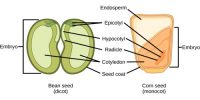The influence of length of daytime on flowering of plants is called Photoperiodism.
In 1920 Garner and Allard observed the affect of photoperiods in Maryland Mammoth a variety of tobacco plant. According to effect of length of day and night (photoperiods) upon the flowering time Gamer and Allard classified the flowering of plants into three classes:
- Short day Plant: These plants flowers when day length is short. Dahlia, Tobacco, Chrysanthemum are short-day plants. They may also call long-night plants. Two species of jute are short-day plants. In 10 – 12 hours photoperiods plants flower in 30 days. More than 1212 hours of photoperiods delayed flowering.
- Long day Plant: These plants give flower when thy-length is longer. Sponge guard (Luffa) Lettuce and Beta palonga (Palong) is long day plants. They may also call short night plants.
- Day-Neutral Plants: Flowering time of these plants does not depend on the duration of daylight. They flower when necessary vegetative growth is completed. Day-neutral plant can be grown in both winter and summer. They flower in both the seasons. Sunflower is a plant of this type. Aus paddy usually a day-neutral plant.
Leaves receive the stimulation of photoperiods.














